Abstract
Lactic acidosis is a clinical condition due to accumulation of H+ ions from lactic acid, characterized by blood lactate levels >5 mM and arterial pH <7.25. In addition to supportive care, treatment usually consists of intravenous NaHCO3, with a resultant mortality >60%. Dichloroacetate (DCA) is a compound that lowers blood lactate levels under various conditions in both man and laboratory animals. It acts to increase pyruvate oxidation by activation of pyruvate dehydrogenase. We evaluated the effects of DCA in the treatment of two different models of type B experimental lactic acidosis in diabetic dogs: hepatectomy-lactic acidosis and phenformin-lactic acidosis. The metabolic and systemic effects examined included arterial blood pH and levels of bicarbonate and lactate; the intracellular pH (pHi) in liver and skeletal muscle; cardiac index, arterial blood pressure and liver blood flow; liver lactate uptake and extrahepatic splanchnic (gut) lactate production; and mortality. Effects of DCA were compared with those of either NaCl or NaHCO3. The infusion of DCA and NaHCO3, delivered equal amounts of volume and sodium, although the quantity of NaHCO3 infused (2.5 meq/kg per h) was insufficient to normalize arterial pH.
In phenformin-lactic acidosis, DCA-treated animals had a mortality of 22%, vs. 89% in those treated with NaHCO3. DCA therapy increased arterial pH and bicarbonate, liver pHi and cardiac index, with increased liver lactate uptake and a fall in blood lactate. With NaHCO3 therapy, there were decrements of cardiac index and liver pHi, with an increase in venous pCO2 and gut production of lactate.
Dogs with hepatectomy-lactic acidosis were either treated or pretreated with DCA. Treatment with DCA resulted in stabilization of cardiac index, a fall in blood lactate, and 17% mortality. NaHCO3 was associated with a continuous decline of cardiac index, rise in blood lactate, and 67% mortality. In dogs pretreated with NaCl, mortality was 33%, but all dogs pretreated with DCA survived. Dogs pretreated with DCA also had lower blood lactate and higher arterial pH and bicarbonate than did those pretreated with NaCl.
Thus, in either of two models of type B experimental lactic acidosis, treatment with DCA improves cardiac index, arterial pH, bicarbonate and lactate, and liver pHi. The mortality in dogs with type B lactic acidosis was significantly less in DCA-treated animals than in those treated with other modalities.
Full text
PDF
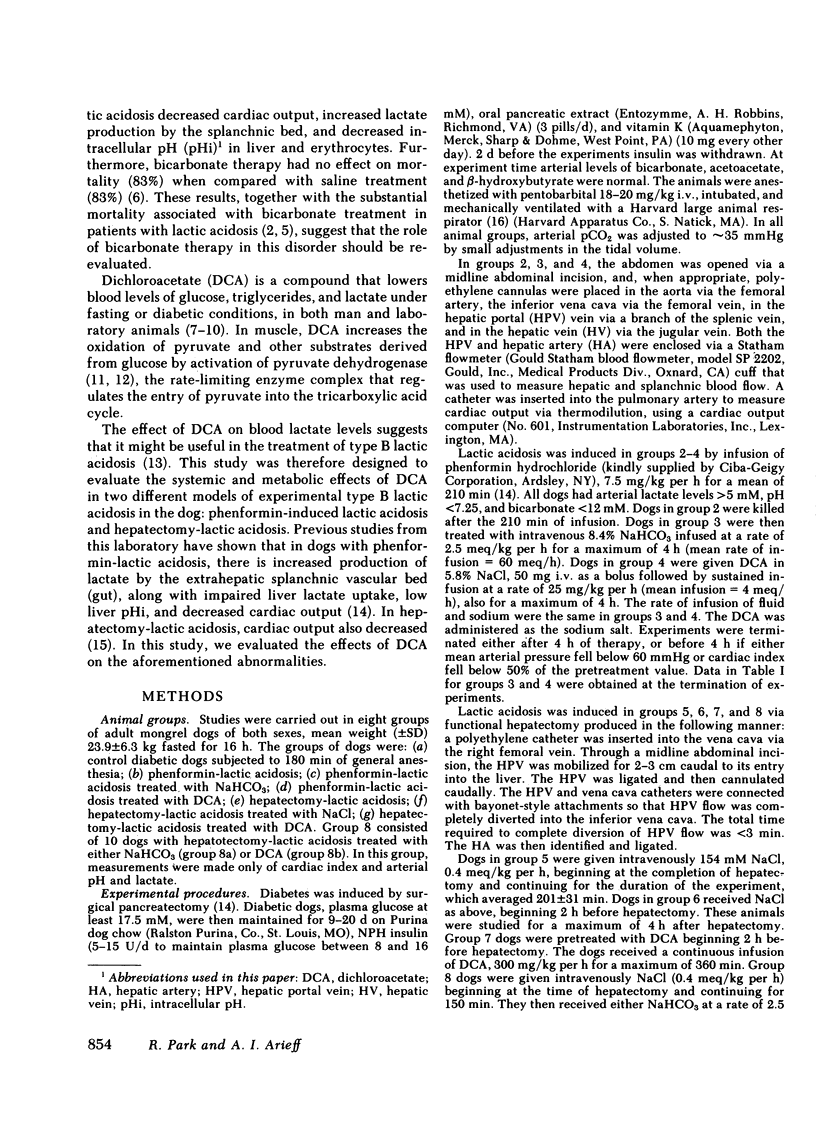


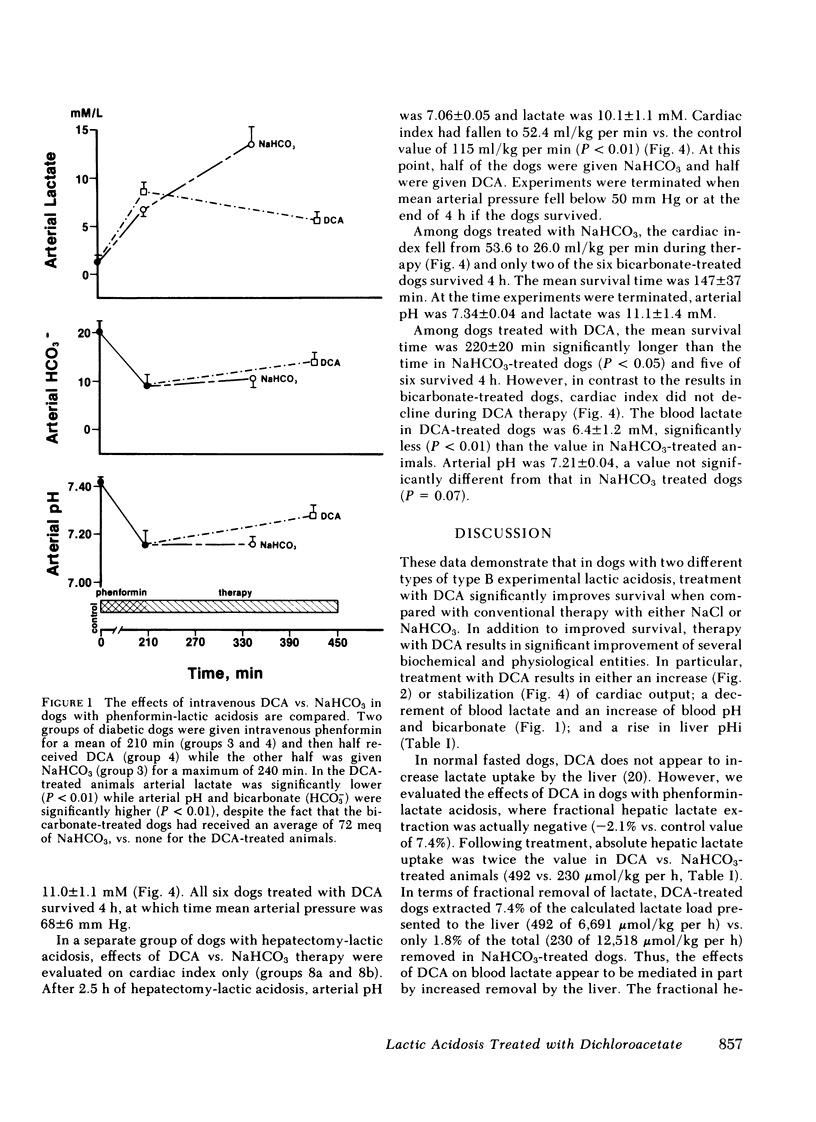
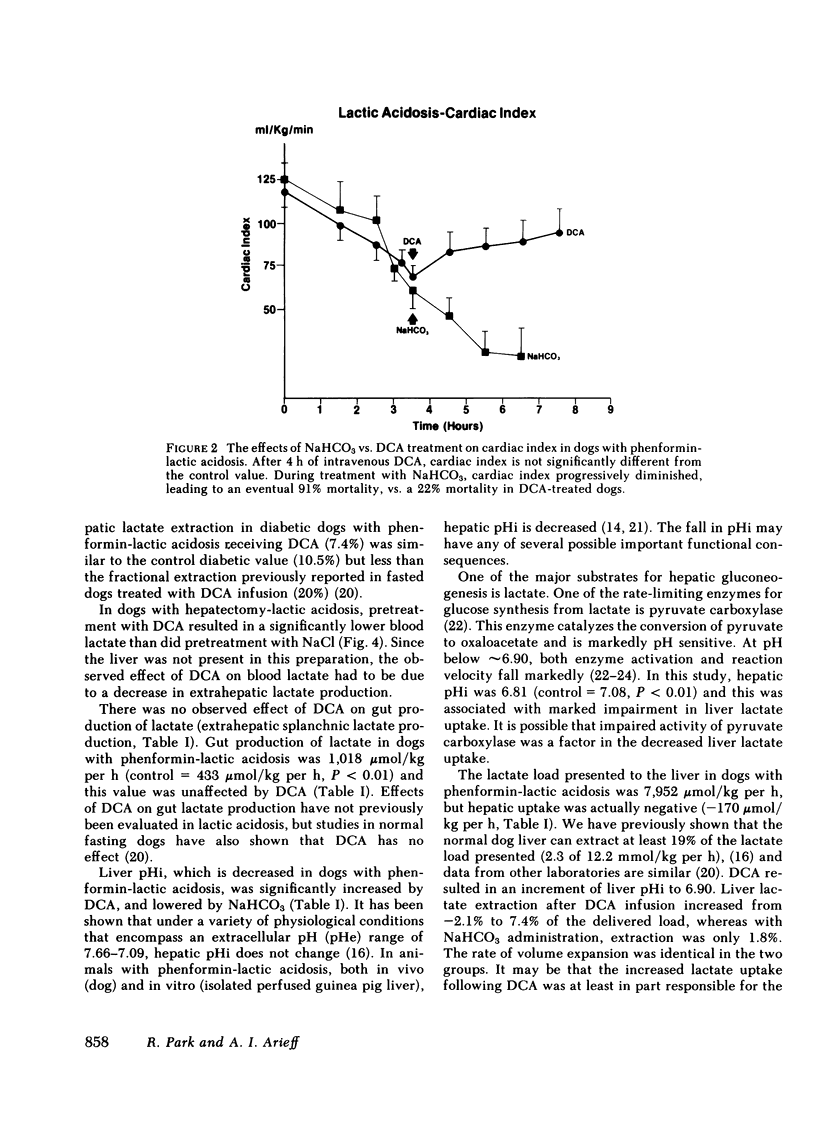
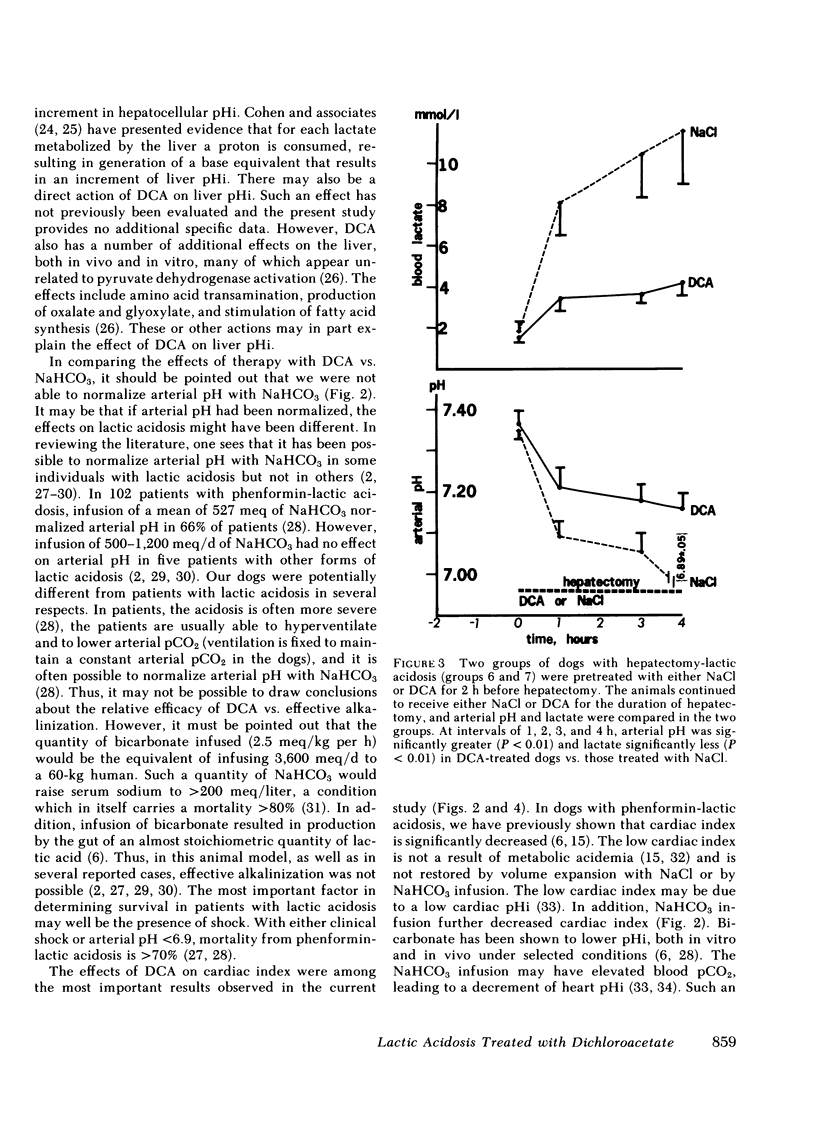
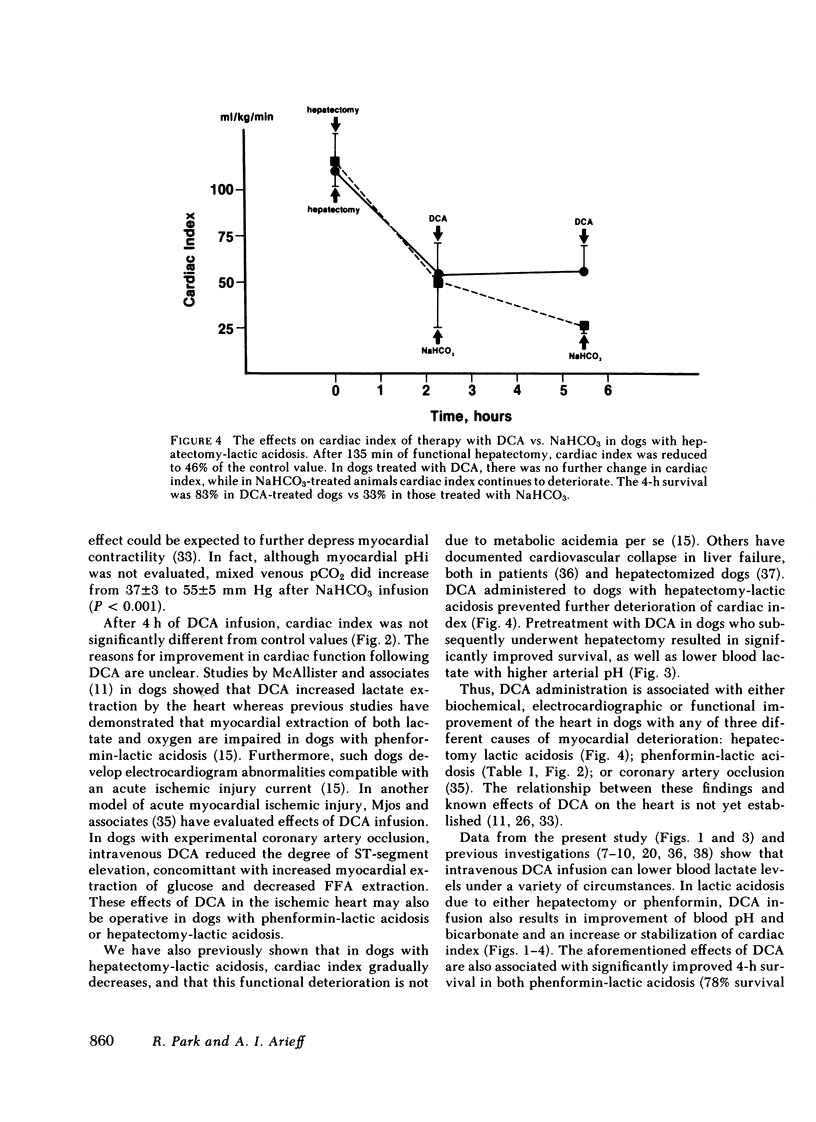
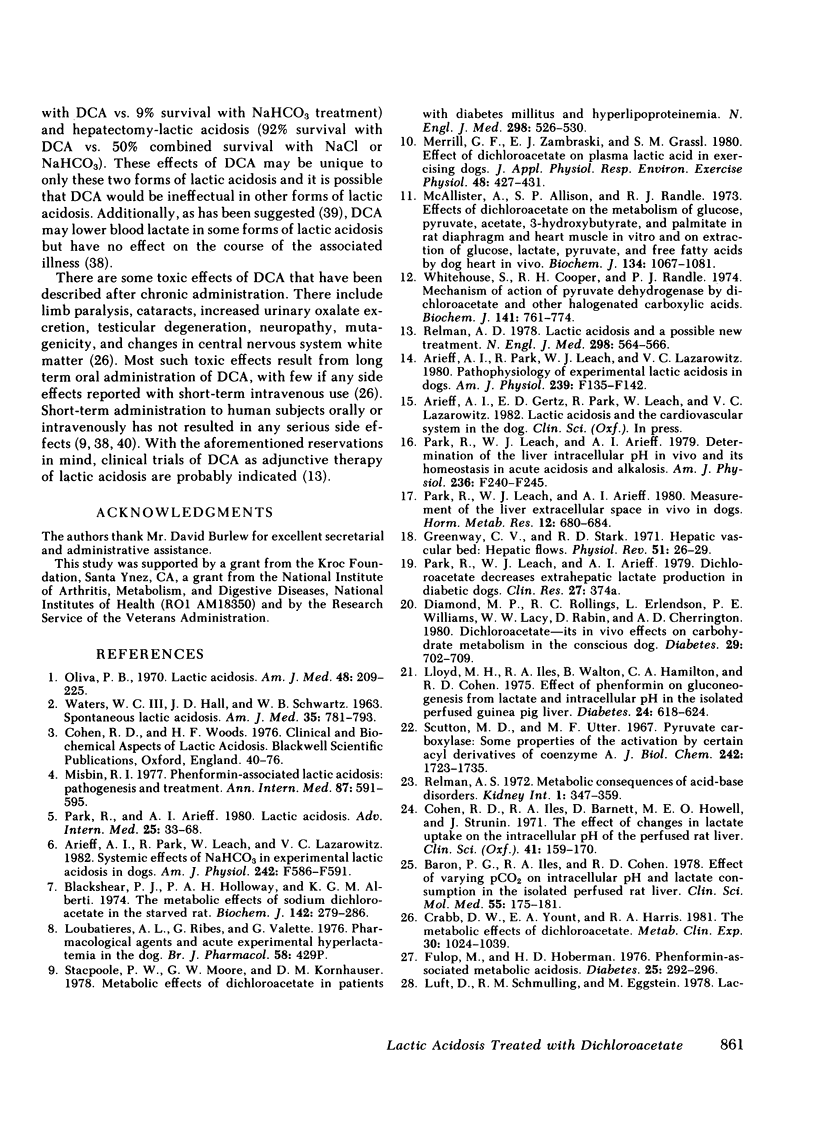
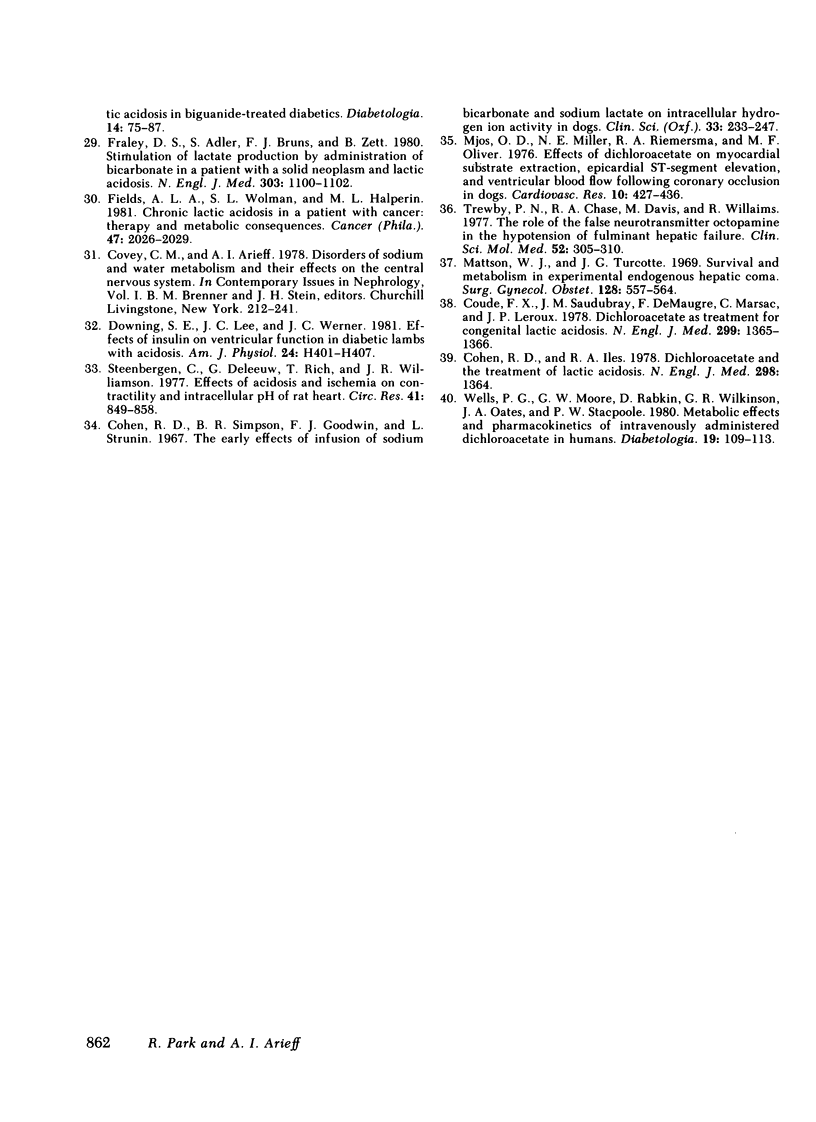
Selected References
These references are in PubMed. This may not be the complete list of references from this article.
- Arieff A. I., Leach W., Park R., Lazarowitz V. C. Systemic effects of NaHCO3 in experimental lactic acidosis in dogs. Am J Physiol. 1982 Jun;242(6):F586–F591. doi: 10.1152/ajprenal.1982.242.6.F586. [DOI] [PubMed] [Google Scholar]
- Arieff A. I., Park R., Leach W. J., Lazarowitz V. C. Pathophysiology of experimental lactic acidosis in dogs. Am J Physiol. 1980 Aug;239(2):F135–F142. doi: 10.1152/ajprenal.1980.239.2.F135. [DOI] [PubMed] [Google Scholar]
- Baron P. G., Iles R. A., Cohen R. D. Effect of varying PCO2 on intracellular pH and lactate consumption in the isolated perfused rat liver. Clin Sci Mol Med. 1978 Aug;55(2):175–181. doi: 10.1042/cs0550175. [DOI] [PubMed] [Google Scholar]
- Blackshear P. J., Holloway P. A., Alberti K. G. The metabolic effects of sodium dichloroacetate in the starved rat. Biochem J. 1974 Aug;142(2):279–286. doi: 10.1042/bj1420279. [DOI] [PMC free article] [PubMed] [Google Scholar]
- Cohen R. D., Iles R. A., Barnett D., Howell M. E., Strunin J. The effect of changes in lactate uptake on the intracellular pH of the perfused rat liver. Clin Sci. 1971 Aug;41(2):159–170. doi: 10.1042/cs0410159. [DOI] [PubMed] [Google Scholar]
- Cohen R. D., Iles R. A. Dichloroacetate and the treatment of lactic acidosis. N Engl J Med. 1978 Jun 15;298(24):1364–1364. doi: 10.1056/NEJM197806152982413. [DOI] [PubMed] [Google Scholar]
- Cohen R. D., Simpson B. R., Goodwin F. J., Strunin L. The early effects of infusion of sodium bicarbonate and sodium lactate on intracellular hydrogen ion activity in dogs. Clin Sci. 1967 Aug;33(1):233–247. [PubMed] [Google Scholar]
- Coude F. X., Saudubray J. M., DeMaugre F., Marsac C., Leroux J. P., Charpentier C. Dichloroacetate as treatment for congenital lactic acidosis. N Engl J Med. 1978 Dec 14;299(24):1365–1366. doi: 10.1056/NEJM197812142992414. [DOI] [PubMed] [Google Scholar]
- Crabb D. W., Yount E. A., Harris R. A. The metabolic effects of dichloroacetate. Metabolism. 1981 Oct;30(10):1024–1039. doi: 10.1016/0026-0495(81)90105-0. [DOI] [PubMed] [Google Scholar]
- Diamond M. P., Rollings R. C., Erlendson L., Williams P. E., Lacy W. W., Rabin D., Cherrington A. D. Dichloroacetate--its in vivo effects on carbohydrate metabolism in the conscious dog. Diabetes. 1980 Sep;29(9):702–709. doi: 10.2337/diab.29.9.702. [DOI] [PubMed] [Google Scholar]
- Downing S. E., Lee J. C., Werner J. C. Effects of insulin on ventricular function in diabetic lambs with acidosis. Am J Physiol. 1981 Sep;241(3):H401–H407. doi: 10.1152/ajpheart.1981.241.3.H401. [DOI] [PubMed] [Google Scholar]
- Fields A. L., Wolman S. L., Halperin M. L. Chronic lactic acidosis in a patient with cancer: therapy and metabolic consequences. Cancer. 1981 Apr 15;47(8):2026–2029. doi: 10.1002/1097-0142(19810415)47:8<2026::aid-cncr2820470821>3.0.co;2-g. [DOI] [PubMed] [Google Scholar]
- Fraley D. S., Adler S., Bruns F. J., Zett B. Stimulation of lactate production by administration of bicarbonate in a patient with a solid neoplasm and lactic acidosis. N Engl J Med. 1980 Nov 6;303(19):1100–1102. doi: 10.1056/NEJM198011063031907. [DOI] [PubMed] [Google Scholar]
- Fulop M., Hoberman H. D. Phenformin-associated metabolic acidosis. Diabetes. 1976 Apr;25(4):292–296. doi: 10.2337/diab.25.4.292. [DOI] [PubMed] [Google Scholar]
- Lloyd M. H., Iles R. A., Walton B., Hamilton C. A., Cohen R. D. Effect of phenformin on gluconeogenesis from lactate and intracellular pH in the isolated perfused guinea pig liver. Diabetes. 1975 Jul;24(7):618–624. doi: 10.2337/diab.24.7.618. [DOI] [PubMed] [Google Scholar]
- Loubatières A. L., Ribes G., Valette G. Pharmacological agents and acute experimental hyperlataemia in the dog [proceedings]. Br J Pharmacol. 1976 Nov;58(3):429P–429P. [PMC free article] [PubMed] [Google Scholar]
- Luft D., Schmülling R. M., Eggstein M. Lactic acidosis in biguanide-treated diabetics: a review of 330 cases. Diabetologia. 1978 Feb;14(2):75–87. doi: 10.1007/BF01263444. [DOI] [PubMed] [Google Scholar]
- Mattson W. J., Jr, Turcotte J. G. Survival and metabolism in experimental endogenous hepatic coma. Surg Gynecol Obstet. 1969 Mar;128(3):557–564. [PubMed] [Google Scholar]
- McAllister A., Allison S. P., Randle P. J. Effects of dichloroacetate on the metabolism of glucose, pyruvate, acetate, 3-hydroxybutyrate and palmitate in rat diaphragm and heart muscle in vitro and on extraction of glucose, lactate, pyruvate and free fatty acids by dog heart in vivo. Biochem J. 1973 Aug;134(4):1067–1081. doi: 10.1042/bj1341067. [DOI] [PMC free article] [PubMed] [Google Scholar]
- Merrill G. F., Zambraski E. J., Grassl S. M. Effect of dichloroacetate on plasma lactic acid in exercising dogs. J Appl Physiol Respir Environ Exerc Physiol. 1980 Mar;48(3):427–431. doi: 10.1152/jappl.1980.48.3.427. [DOI] [PubMed] [Google Scholar]
- Misbin R. I. Phenformin-associated lactic acidosis: pathogenesis and treatment. Ann Intern Med. 1977 Nov;87(5):591–595. doi: 10.7326/0003-4819-87-5-591. [DOI] [PubMed] [Google Scholar]
- Mjos O. D., Miller N. E., Riemersma R. A., Oliver M. F. Effects of dichloroacetate on myocardial substrate extraction, epicardial ST-segment elevation, and ventricular blood flow following coronary occlusion in dogs. Cardiovasc Res. 1976 Jul;10(4):427–436. doi: 10.1093/cvr/10.4.427. [DOI] [PubMed] [Google Scholar]
- Oliva P. B. Lactic acidosis. Am J Med. 1970 Feb;48(2):209–225. doi: 10.1016/0002-9343(70)90117-8. [DOI] [PubMed] [Google Scholar]
- Park R., Arieff A. I. Lactic acidosis. Adv Intern Med. 1980;25:33–68. [PubMed] [Google Scholar]
- Park R., Leach W. J., Arieff A. I. Determination of liver intracellular pH in vivo and its homeostasis in acute acidosis and alkalosis. Am J Physiol. 1979 Mar;236(3):F240–F245. doi: 10.1152/ajprenal.1979.236.3.F240. [DOI] [PubMed] [Google Scholar]
- Park R., Leach W. J., Arieff A. I. Measurement of the liver extracellular space in vivo in dogs. Horm Metab Res. 1980 Dec;12(12):680–684. doi: 10.1055/s-2007-999231. [DOI] [PubMed] [Google Scholar]
- Relman A. S. Lactic acidosis and a possible new treatment. N Engl J Med. 1978 Mar 9;298(10):564–565. doi: 10.1056/NEJM197803092981009. [DOI] [PubMed] [Google Scholar]
- Relman A. S. Metabolic consequences of acid-base disorders. Kidney Int. 1972 May;1(5):347–359. doi: 10.1038/ki.1972.46. [DOI] [PubMed] [Google Scholar]
- Scrutton M. C., Utter M. F. Pyruvate carboxylase. IX. Some properties of the activation by certain acyl derivatives of coenzyme A. J Biol Chem. 1967 Apr 25;242(8):1723–1735. [PubMed] [Google Scholar]
- Stacpoole P. W., Moore G. W., Kornhauser D. M. Metabolic effects of dichloroacetate in patients with diabetes mellitus and hyperlipoproteinemia. N Engl J Med. 1978 Mar 9;298(10):526–530. doi: 10.1056/NEJM197803092981002. [DOI] [PubMed] [Google Scholar]
- Steenbergen C., Deleeuw G., Rich T., Williamson J. R. Effects of acidosis and ischemia on contractility and intracellular pH of rat heart. Circ Res. 1977 Dec;41(6):849–858. doi: 10.1161/01.res.41.6.849. [DOI] [PubMed] [Google Scholar]
- Trewby P. N., Chase R. A., Davis M., Williams R. The role of the false neurotransmitter octopamine in the hypotension of fulminant hepatic failure. Clin Sci Mol Med. 1977 Mar;52(3):305–310. doi: 10.1042/cs0520305. [DOI] [PubMed] [Google Scholar]
- WATERS W. C., 3rd, HALL J. D., SCHWARTZ W. B. SPONTANEOUS LACTIC ACIDOSIS. THE NATURE OF THE ACID-BASE DISTURBANCE AND CONSIDERATIONS IN DIAGNOSIS AND MANAGEMENT. Am J Med. 1963 Dec;35:781–793. doi: 10.1016/0002-9343(63)90240-7. [DOI] [PubMed] [Google Scholar]
- Wells P. G., Moore G. W., Rabin D., Wilkinson G. R., Oates J. A., Stacpoole P. W. Metabolic effects and pharmacokinetics of intravenously administered dichloroacetate in humans. Diabetologia. 1980 Aug;19(2):109–113. doi: 10.1007/BF00421855. [DOI] [PubMed] [Google Scholar]
- Whitehouse S., Cooper R. H., Randle P. J. Mechanism of activation of pyruvate dehydrogenase by dichloroacetate and other halogenated carboxylic acids. Biochem J. 1974 Sep;141(3):761–774. doi: 10.1042/bj1410761. [DOI] [PMC free article] [PubMed] [Google Scholar]


